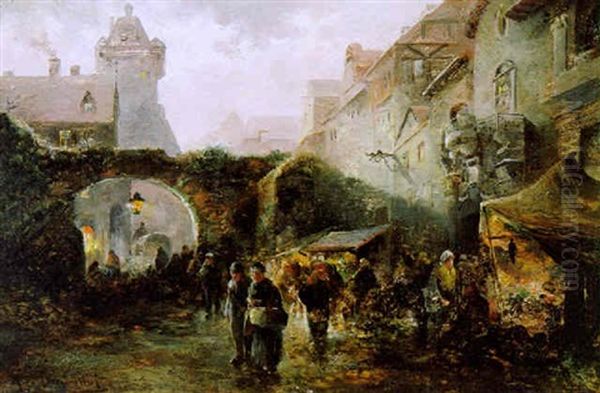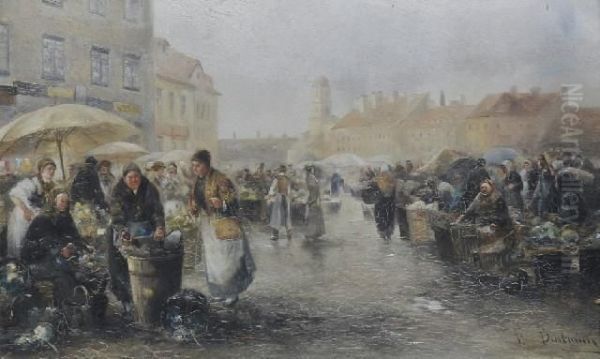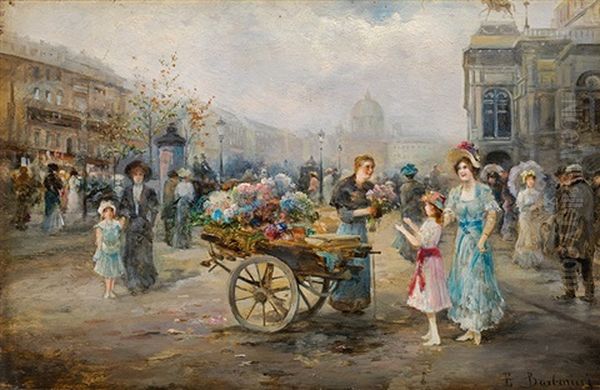Emil Barbarini stands as a notable figure in Austrian art history, particularly recognized for his evocative depictions of bustling market squares and his sensitive handling of light. Born in Vienna in 1855 and passing away in the same city in 1930, Barbarini carved a niche for himself, distinct from his artist father, capturing the vibrant energy of everyday life in Austria and beyond during the late 19th and early 20th centuries. His work offers a window into the social fabric and visual atmosphere of his time, rendered with a keen eye for detail and atmospheric nuance.
Viennese Roots and Artistic Beginnings
Emil Barbarini was born into an artistic household in Vienna, the capital of the Austro-Hungarian Empire and a thriving center of European culture. His father, Franz Barbarini (1804-1873), was himself a well-regarded painter, primarily known for his landscapes, particularly those featuring Alpine scenery. It was under his father's tutelage that Emil received his initial artistic training. This familial connection provided a foundational understanding of painting techniques and the artistic landscape of the time.
However, Emil Barbarini did not simply replicate his father's style or subject matter. While Franz Barbarini often focused on the grandeur of nature, particularly the Austrian Alps, Emil quickly developed his own artistic voice. He demonstrated an independent spirit, forging a path that diverged significantly from his father's more traditional landscape focus. Emil gravitated towards the human element within the landscape, finding particular inspiration in the dynamic activity of urban and town life.
Development of a Distinct Style: Light and Atmosphere
Emil Barbarini's mature style is characterized by his fascination with market scenes, town squares, and public gatherings. He possessed a remarkable ability to capture the specific mood and energy of these locations. His canvases often teem with figures – vendors arranging their wares, shoppers browsing, people conversing – creating a lively tableau of daily commerce and social interaction. He painted scenes not only in his native Vienna and other Austrian towns like Krems but also reportedly drew inspiration from travels to France, Belgium, and the Netherlands, broadening his visual repertoire.

A defining feature of Barbarini's technique was his interest in the effects of light. He was known to paint the same subject multiple times, capturing it at different times of the day. This practice allowed him to explore the subtle shifts in illumination and shadow, revealing how light could transform the appearance and atmosphere of a scene. This methodical approach to observing and rendering light, focusing on its transient qualities, bears a technical similarity to the methods employed by French Impressionist painters like Claude Monet and Camille Pissarro, who famously painted series of haystacks or cathedrals under varying light conditions. While Barbarini wasn't formally part of the Impressionist movement, his dedication to capturing specific moments of light demonstrates a shared sensibility regarding atmospheric effects. His works often achieve a delicate balance between harmony and contrast, using light not just for illumination but as a key compositional and emotional element.
Chronicler of the Marketplace: Signature Themes
The marketplace became Emil Barbarini's signature milieu. He excelled at depicting the organized chaos, the vibrant colors, and the human interactions inherent in these settings. His paintings often focus on specific types of markets, providing valuable visual records of urban life and commerce at the turn of the century. Works like The Vegetable Market and Weihnachtsmarkt (Christmas Market) exemplify this focus. In these paintings, one can observe the careful arrangement of produce, the textures of fabrics, the gestures of trade, and the overall buzz of activity.
His depictions were not merely documentary; they were imbued with atmosphere. Whether capturing the bright sunlight of a summer morning market or the softer, perhaps gaslit glow of an evening gathering, Barbarini conveyed a sense of place and time. He often used relatively small canvases for these detailed scenes, such as the work titled Market Square measuring 32 x 21 cm, which required a meticulous approach to detail within a compact format. Another example, Flower Seller (also 32 x 21 cm), likely focused on the vibrant hues and textures associated with floral displays, a recurring motif in his market scenes.
Notable Works and Recognition
Several specific works stand out in Emil Barbarini's oeuvre. Bad Aussee, a painting measuring 32 x 26 cm, depicts a location in the Salzkammergut region of Austria, known for its scenic beauty. This suggests that while markets were a primary focus, Barbarini also engaged with landscape and townscape painting outside the bustling city center, perhaps reflecting his father's influence but interpreted through his own lens. Bad Aussee is noted as one of his signed pieces, indicating its significance.
His Viennese market scenes are particularly well-known. Paintings depicting the famous Naschmarkt or various Blumenmarkt (Flower Markets) in Vienna capture the specific character of these iconic locations. One documented Blumenmarkt in Wien was executed in oil on wood, measuring 26 x 39 cm, showcasing his skill in rendering the textures and colors of flowers and the interactions of vendors and customers. These works are appreciated for their realism and the lively atmosphere they convey.

Barbarini sometimes used the pseudonym "E. Rovier" when signing his works, a practice not uncommon among artists of the period for various personal or commercial reasons. Regardless of the signature, his stylistic hallmarks remain consistent. The frequent appearance of his paintings in auctions, both historically and in the contemporary art market, attests to his enduring appeal and recognized status among collectors of Austrian art. An example includes an autumn rural scene (oil on canvas, 69 x 107 cm) which fetched €2500 at auction, indicating a market for his larger landscape works as well.
Artistic Context: Vienna Around 1900
Emil Barbarini worked during a dynamic period in Viennese and European art. While he maintained his distinct focus on realistic genre scenes, Vienna itself was a crucible of artistic innovation. The late 19th century saw the dominance of Historicism, exemplified by the grand style of Hans Makart. However, by the turn of the century, the Vienna Secession movement emerged, challenging academic traditions. Artists like Gustav Klimt, Egon Schiele, and Koloman Moser were forging new paths towards Modernism, exploring symbolism, expressionism, and decorative styles.
Barbarini does not appear to have been directly involved with the Secession or other avant-garde movements. His style remained rooted in a form of detailed realism, focusing on observation and traditional representation. Yet, his work coexisted with these newer trends. He can be seen alongside other Austrian artists who continued to explore landscape and genre painting, such as Tina Blau, known for her atmospheric landscapes and city scenes, or Rudolf von Alt, a master watercolorist celebrated for his detailed views of Vienna. Even within the Secession, artists like Carl Moll explored atmospheric landscapes influenced by Impressionism. Barbarini's contribution lies in his consistent dedication to capturing everyday life, particularly market scenes, with a sensitivity to light and atmosphere that gives his work a unique charm and historical value. His father, Franz Barbarini, represents the earlier generation of landscape painters from whom Emil initially learned.
Technique and Materials
Barbarini primarily worked in oil paint, applying it to various supports including wood panel and canvas. His technique involved careful brushwork, allowing him to render the fine details necessary for his populated market scenes and the textures of goods, clothing, and architecture. The dimensions of his known works vary, ranging from the smaller, intimate panels depicting specific market interactions or figures like the Flower Seller, to larger canvases used for more expansive rural or landscape views.

His palette likely adapted to the scene and the time of day he was depicting. Market scenes would necessitate a vibrant range of colors to capture the variety of goods, flowers, and clothing, while landscapes like Bad Aussee or the autumn rural scene might employ more tonal variations to convey natural light and seasonal atmosphere. His skill lay in harmonizing these colors and tones to create a cohesive and believable representation.
Legacy and Historical Evaluation
Emil Barbarini's legacy rests on his contribution to Austrian genre painting. He stands out for his consistent focus on market scenes, a theme he explored with dedication and skill. His ability to capture the interplay of light and shadow, and to render the specific atmosphere of a place and time, elevates his work beyond mere documentation. He provides a valuable visual record of everyday life in Vienna and other locations during a period of significant social and cultural change.
While perhaps not an innovator on the scale of the Secessionists, Barbarini mastered his chosen niche. His paintings were, and remain, appreciated for their detailed realism, their vibrant depiction of social life, and their atmospheric qualities. Contemporary and later evaluations often praise his fine brushwork, his sensitivity to color, and his ability to create lively, engaging compositions. His works hold a firm place in Austrian art history as charming and skillful representations of the late 19th and early 20th centuries.
He can be situated within a broader European tradition of genre painting. His detailed market scenes might distantly echo the lively peasant gatherings of Dutch Golden Age painters like Jan Steen, or find parallels in the depictions of modern urban life by later 19th-century artists like the French painter Jean Béraud, known for his scenes of Parisian boulevards and society, or the German realist Adolf von Menzel, admired for his meticulous observation of everyday scenes and historical events. Barbarini’s specific contribution is his focus on the Austrian context, rendered with his characteristic attention to light and detail.
Emil Barbarini remained active as a painter throughout his life, living and working in Vienna until his death in 1930. He appears to have developed his style independently after initial training with his father, and there is no record of him being formally associated with specific art movements or exhibiting societies beyond the general art scene. His enduring presence in the art market confirms the continued appreciation for his skillful and evocative paintings, which preserve a glimpse into the vibrant world of Austrian markets and landscapes of a bygone era.